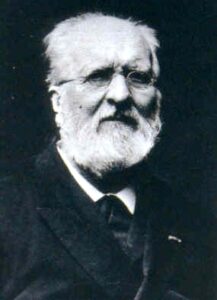Name Louis Laurent Gabriel de Mortillet
Date of birth August 29, 1821 (Meylan, Isère)
Date of death September 25, 1898 (Saint-Germain-en-Laye, Yvelines)
Short biography:
- Studied for 5 years at the Jesuit College of Chambéry;
- He studied at the Conservatoire des Arts et Métiers in Paris where he acquired a solid knowledge of geology (geological engineer) before taking courses in botany, chemistry, zoology and geology at the National Museum of Natural History in Paris;
- Both a republican and a revolutionary, he had to flee France for press offenses (he was the author of a pamphlet entitled La guillotine). He fled to Savoy before going into exile in Switzerland where he made his debut in the field of prehistory;
- 1851: moved to Geneva where he classified the collections of the National Museum of Natural History;
- 1856: participation as a geological engineer in the construction of the Lombardy-Venice railroad;
- 1863: return to France following his amnesty in 1859;
- 1864: foundation of the journal Matériaux pour l’histoire positive et philosophique de l’Homme which became the official journal of Prehistory in French-speaking Europe;
- 1866-1867: participates in the classification of the prehistoric collections of Jacques Boucher de Perthe in the museum of Saint-Germain en Laye (the current museum of national archaeology);
- 1868: Appointed attaché of conservation of the museum of Saint-Germain en Laye. The museum became his place of study and he developed his typological classifications of human industries;
- Participation in the creation of the International Congresses of Anthropology and Prehistoric Archaeology
- 1875: Co-founder with Paul Broca of the Paris School of Anthropology
- From 1876: Holder of the chair of prehistoric anthropology at the School of Anthropology in Paris
- 1883: publication of his first book, Le Préhistorique, Antiquité de l’Homme (available in digital version on Gallica-BnF). It is both a synthesis of several years of research and a didactic work for the public and anyone interested in prehistoric archaeology. Going from the Tertiary era to the Gallic era and structured according to different themes (archaeological documents, geological data, etc.), this work allows Mortillet to develop his chronology of the different cultural periods based on the lithic industry on which he has been working for several years already
Gabriel de Mortillet and Prehistory
Often considered as one of the founding fathers of Prehistory.
In 1869, Gabriel de Mortillet proposed a first chronocultural system in which he used the stratotype principle which consists in using the name of a place to define a culture (the Mousterian described from the industry found at the Moustier site, the Solutrean from the Solutré site, etc.). He also used this principle to describe the Acheulean period for the first time in 1872, based on the lithic industry found at the Saint-Acheul site.
The chronological question is at the heart of Gabriel de Mortillet’s work because it makes it possible to establish the stages of development of past societies. Mortillet has a progressive and linear vision of the evolution of human societies, which can be felt throughout his work. For example, he distinguishes between two main kingdoms: that of flint and that of bone. According to him, the reign of the flint is prior to the reign of the bone because the latter involves more advanced technologies than those used during the reign of the flint. Thus, populations that cut flint are less evolved than populations that use both flint and bone. This presupposition will lead him to make chronological errors, as is the case, for example, for the Aurignacian, which Mortillet considers to be a more recent culture because of the presence of bone assegais.
Reign of the flint:
Period of Solutré
The Moustier era
Reign of the bone:
Era of the Madeleine
Aurignac’s era
Nevertheless, in the field, this does not work and the Aurignacian is found in stratigraphic layers prior to the Magdalenian. Gabriel de Mortillet will then remove the Aurignacian from his chronology. Gabriel de Mortillet reigns unchallenged on Prehistory and it will be necessary to wait 30 years for a new chronology published in 1912 by Henri Breuil to give back its place to the Aurignacian. This event will be known thereafter as “the battle of the Aurignacian” which will be settled on the ground and that will win Henri Breuil, another extremely important figure of the Prehistory.
Gabriel de Mortillet remains an important figure in prehistory. Indeed, it will contribute to make prehistory a scientific discipline in its own right.
Indicative bibliography of Gabriel de Mortillet:
- [1868] “L’Homme dans les temps géologiques”, Bulletin de la Société géologique de France, t. 25,2nd series, meeting of December 2, 1867, p. 180-184(read online[archive] [at biodiversitylibrary.org]).
- [1872] “Classification of the Stone Age,” Materials for the Primitive and Natural History of Man, vol. 7, year eight,2nd series, t. 3, 1872, p. 464-465.
- [1874] “On the non-existence of a people of the dolmens” (reproduction of a communication presented at the Congress of Stockholm), Materials for the primitive and natural history of the Man, vol. 9,2nd series, t. 5, 1874, p. 349-353(read online[archive] [on gallica]).
- [1874] “The Bronze Age,” Materials for the Early and Natural History of Man, vol. 9,2nd series, t. 5, 1874, p. 353-356(read online[archive] [on gallica]).
- [1875] “L’Acheuléen et le Moustérien. à propos du Mont Dol et du Bois du Rocher,” Matériaux pour l’histoire primitive et naturelle de l’Homme, vol. 10,2nd series, t. 6, 1875, p. 174-176(read online[archive] [on gallica]).
- [1876] “Tableau du système de classification des périodes préhistoriques selon Mortillet,” Matériaux pour l’histoire primitive et naturelle de l’Homme, vol. 11,2nd series, t. 7, 1876, p. 545(read online[archive] [on gallica]).
- [1878] “Exact determination of the Solutrean position,” Materials for the Early and Natural History of Man, vol. 13,2nd series, t. 9, 1878, p. 15-17(read online[archive] [on gallica]).
- [Mortillet & Mortillet 1881] Prehistoric Museum, Paris, ed. Reinwald, 1881.
- [1883] La Préhistoire: origine et antiquité de l’homme [“Prehistory: origin and antiquity of man”], Paris, libr. Schleicher Frères, coll. “Bibliothèque des sciences contemporaines”, 1883 (repr. 1900, 1910[archive]), 642 pp.(read online[archive] [PDF] on archive.org).
- [1897] Formation of the French nation: texts, linguistics, paleontology, anthropology, Paris, ed. Félix Alcan, coll. ” International Scientific Library,” 1897, on gallica(read online[archive]).



